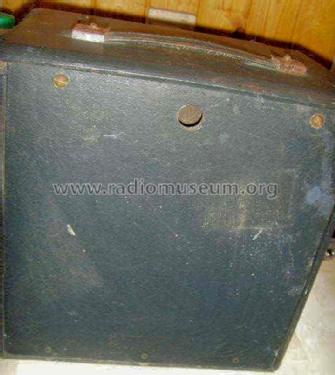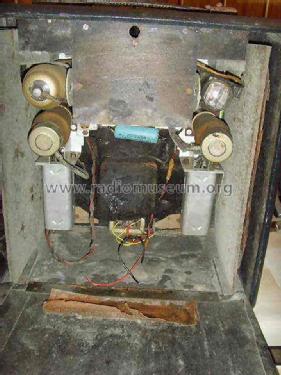New Baby Q All Dry cover
Pye Ltd., Radio Works; Cambridge
- Produttore / Marca
- Pye Ltd., Radio Works; Cambridge
- Anno
- 1940
- Categoria
- Radio (o sintonizzatore del dopoguerra WW2)
- Radiomuseum.org ID
- 78820
- Numero di tubi
- 4
- Principio generale
- Supereterodina (in generale); ZF/IF 469 kHz
- Gamme d'onda
- Onde medie (OM) e onde lunghe (OL).
- Tensioni di funzionamento
- Batterie a secco / 1,5 & 90 Volt
- Altoparlante
- AP magnetodinamico (magnete permanente e bobina mobile)
- Materiali
- Pelle / stoffa / plastica ma con altro materiale sottostante
- Radiomuseum.org
- Modello: New Baby Q All Dry [cover] - Pye Ltd., Radio Works;
- Forma
- Apparecchio portatile > 20 cm (senza la necessità di una rete)
- Dimensioni (LxAxP)
- 11.5 x 12 x 7.5 inch / 292 x 305 x 191 mm
- Annotazioni
-
The main visual difference btween the Baby Q Senior and New Baby Q All Dry is the cabinet style/colouring (single tone). The Trader 534 only lists later Mullard Octal for the Baby Q Senior though with US numbering (described as Mullard Amerty) and lists DK1 DF1 DAC1 DL2 for this New Baby Q. Before 1942 the Edge connect valves are unavailable. By 1946 Philips numbering used by Mullard: There are also some small component differences (listed by Trader 534 30th August 1941)
Generally from 1939 DK1 DF1 DAC1 DL2 but from late 1941 1A7G 1N5G 1H5G 1C5G, then in 1946:
DK32 replaces 1A7G
DF33 replaces 1N5G
DAC32 replaces 1H5G
DL35 replaces 1C5GThe edge (P8) and Octal valves/tubes are not base compatible but different production times and electrically similar. This occurs on many UK battery models between 1940 and 1945. Even in 1945 / 1946 the Edge connect types are unavailable and Mullard issues instructions on how to change the sockets from P8 Edge type to International octal and the list of Octal replacements. These changes are seen on Ever Ready, McMichael and others.
- Fonte dei dati
- Radio! Radio!
- Letteratura / Schemi (1)
- Trader Service Sheet (suppl. of Wireless & El. Trader, etc.) (534)
- Autore
- Modello inviato da Konrad Birkner † 12.08.2014. Utilizzare "Proponi modifica" per inviare ulteriori dati.
- Altri modelli
-
In questo link sono elencati 628 modelli, di cui 484 con immagini e 342 con schemi.
Elenco delle radio e altri apparecchi della Pye Ltd., Radio Works; Cambridge






